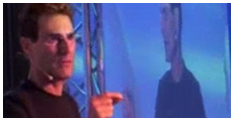ANALYZING THE GELLER EFFECT
by John G. Taylor, Ph.D., Department of Mathematics,
King’s College, University of London.
THE GELLER EFFECT involves the bending or breaking of objects, usually metal, by certain people in situations in which such results are scientifically impossible. The overt methods used are either a gentle stroking of the object or mental concentration on it without any direct contact with the specimen being distorted. At least fifty cases have been reported in this country, and similar numbers have been noted in other countries after visits by Uri Geller, the majority of the subjects being children. The effect itself is clearly a challenge to science, and requires a thorough investigation. This is especially attractive since the materials being distorted have structures that are reasonably well understood. What is more, the amounts of energy involved must be considerable because they cause metal objects to bend or break, so whatever mechanism is involved cannot be too elusive to be observed by reasonably sensitive apparatus. The prognosis for a complete analysis of the effect is therefore good.
The first question concerns the validity of the effect. Many instances of it have been reported under highly variable conditions.(1) The emergence of subjects with metal-bending powers has allowed more careful analysis with controlled surroundings. The repeatability of the effect due to the persisting powers of the subjects has permitted simple tests to be designed; they quite clearly validate the Effect.(1,2) That does not mean that all cases of metal bending have to be accepted as belonging to the Geller Effect, but sufficient precaution can be taken to prevent fraud. The pressure being applied during stroking of a specimen can always be measured by the experimenter either holding one end of the object or attaching it to a suitable spring balance. Less certain, but still reasonable, is the very careful direct observation during the bending process itself. The majority of the results to be reported here involved the latter process, but only with subjects whose ability to bend material was already validated.
The next step in the scientific analysis of the Geller Effect is to determine the range of the phenomenon itself. This involves such things as the range of materials that can be affected, the variation of ease of bending according to the shape of the material, and the comparison of the powers possessed by different people. More technical questions, such as what associated phenomena – temperature change, current flow, etc. – occur in the metal or other material during distortion, also need to be answered, as do the possible forms of radiation that could be used to transmit energy to the specimen. There are also related disturbances that may be helpful to consider, and that are brought about specifically by the metal-bending subjects. In this paper we attempt to present preliminary data on these matters obtained from work with a number of young subjects (all under the age of sixteen) as well as with Uri Geller. (A microanalysis of the objects is underway.)
The final step is to determine the mechanisms involved in the Geller Effect. That is inextricably tied to the results of the experiments mentioned above, but it was felt appropriate to attempt as descriptive a discussion as possible before soaring to the rarefied atmosphere of theoretical analysis. Clearly the choice of experiments is partially guided by the mechanisms available. This, must not prevent all possible mechanisms from being investigated without prejudice. The existence of the Geller Effect alone shows that the scientifically impossible can sometimes occur.
The range of materials that can be bent or broken is broad. The metals include copper, aluminum, brass, several forms of steel, tin, lead, zinc, and silver. The first four of these have been affected by subjects under conditions in which the pressure applied to metals was measured or when there was no direct contact. The remainder have been distorted under less strict conditions but still when only gentle pressure appeared to be applied, and by children whose powers on the first four metals had been validated under strict conditions. Plastics have also been distorted by children. The plastics were tensile test specimens of polystyrene and polycarbonate. Ionic crystals have also been affected without direct contact.(2) Single crystals of both LiF and NaCl were fractured, the former with marked disintegration, and both fractures were made by Uri Geller. Silicon has been affected, as reported earlier.(2) Other materials have also been reported as being distorted; one was wood, though the experimenter has not observed this directly. It is clearly important to know the exact range of materials that are amenable, since important clues to the effect could result from such knowledge. In particular it is of value to learn if it is only materials with a certain degree of regularity in their structure that are at risk.
The next question is that of the effect of the shape of the specimen on ease of distortion. The results would indicate whether the Geller Effect involves the whole specimen being distorted or only a portion of it. To test this feature, standard specimens of different sizes were used with two subjects (A and B) whose bending powers had been validated on other specimens.(2) The first test involved five specimens of aluminum, each with a cross section of 0.6 x 0.2 cm. Every specimen was stroked gently by subject A for a period of seven minutes. The specimens were tested successively with a rest of two minutes in between each. The resulting degree of bending is given in Table 1. There is a clear relation of length of specimen to ease of bending, the best case being for that with a length of 19.4 cm. This result was supported by a similar test performed at an earlier time by the mother of subject A; the results are also given in Table 1. The times are not exactly comparable with those of the later test, but it was found that a strip about 20 cm long was bent most easily. Tests were also done under parental supervision with subject B. The results are shown in the table; the maximum length for the copper specimens used was 13.5 cm. Tests were also set up, again under parental supervision, with subject A using copper strips 2.6 cm wide. Here again the longest strip bent most rapidly. It is clear that the length of the specimen is of considerable importance in the bending process; the influence of cross section is not so apparent, and obviously more work needs to be done on this.
Table 1. Variations in the length of metal specimens and the ease of bending them
Material Details
Sub- Super- and cross of
ject visor section bending
A Experi- Aluminum Length (cm) 5.0 12.4 19.4 50.0 100.0
menter’ 0.6*0.20 Degree of 0 0 32 14 6
cm bending
Time (min) 7 7 7 7 7
A Parent ditto Length (cm) 5.1 9.4 18.6
Degree of 0 125 178
bending
Time (min) 8 4.75 2.75
B ditto Copper Length (cm) 5 10 13.5 15.5
0.6 x 0.2 Degree of 0 4 1.1 1.0
CM. bending
Time (min) 25 15 10 1.0
A ditto Copper Length (cm) 5.4 10.1 17.3 19.9
2.6 x 0.15 Degree of 0 0 4 15
cm bending
Time (min)
There are also data about the subjects with metal-bending powers. At least fifty such cases have been reported to the experimenter by reliable witnesses, though he has personally investigated only twenty-five of these cases, and of these only six were observed in action, making it possible to say they were genuine. There are only four adults among the fifty persons reported, all the others being under the age of sixteen; no adults are present at all among the six observed most closely by the experimenter. The youngest child observed is seven and a half (a four-and-a-half-year-old has been reported as having metal-bending ability, but the child’s alleged talent was not directly studied by this experimenter). The average age of the children is about twelve, and they are roughly divided equally between boys and girls. The outstanding feature of these statistics is the complete exclusion of adults from the select group; its explanation might be found in physiological changes normally occurring at puberty.
It is also of value to investigate what is taking place in the specimen itself during bending. At the macroscopic level, measurements have been made of temperature changes by taping a 0.3-cm-long thermocouple to each specimen. No temperature changes of more than 2 degrees C have been recorded during the bending process. This change is on the order of that expected when a specimen is touched by the hands. Microheating in the interior of a specimen could have escaped notice by such a measurement, but microanalysis to date indicates the absence of any such effects.
In a similar fashion any possible current flow occurring during bending was measured by means of wires soldered to metal specimens. Specimens of various shapes were used, the main ones being copper strips, each with a cross section of 0.6 x 0.2 cm and a length of 10 to 15 cm. The wires were attached at the mid point and near one end of each specimen. Changes of potential were measured on either D.C. or A.C. millivoltmeters. The sensitivity of the measurements was increased by a factor of 1000 by a suitable voltage amplifier. In three cases of bending of the Cu strips, one case involving a bend of over one hundred and eighty degrees, no deflections of the apparatus were recorded on the most sensitive scales. The corresponding potential differences were below 25 micro Volts at D.C. and 0.1 micro Volts over the frequency range of 1 Hz to 3 MHz.
Any radiant energy transferred to the specimen during bending was also accessible to measurement. The first type of radiation investigated was of the ionizing variety. A portable radiation monitor Type 5-40 with an x-ray scintillation probe Type 5-42, made by Mini Instruments, sensitive to 3-100 keV photons, or a larger Airmac radiation monitor 1021B was used in various tests with known subjects, the radiation probes being placed as close as possible to the specimen being affected. No readings above background radiation were observed, to within the accuracy of the equipment, in three separate sessions when bending occurred with five subjects. Nor were there any effects, during these tests, on the discharge rate of a gold-leaf electroscope. For example, in one test the electroscope deflection decreased twenty degrees in twenty minutes while bending occurred; a similar reduction, to within 5%, occurred due to normal charge leakage. The only way in which ionizing radiation could have been involved was if it were so highly focused as to have evaded the radiation probes.
Ultraviolet radiation was tested for by the use of metal strips coated with sodium salicylate and enclosed in quartz tubes. The strips were treated as specimens to be distorted, the attempts being made by subjects in reduced illumination so as to observe any fluorescence, appearing as a violet glow, produced by ultraviolet radiation. The strips were also placed nearby when standard specimens were bent. There were some violet flashes seen while the tubes were rubbed (though no bending of the treated strips occurred). but roughly the same number of flashes, and with the same level of illumination, were obtained by purely frictional effects at a different time. Otherwise no fluorescence occurred. The total fluorescence in all cases was less than that produced by illuminating the tube with a helium vapor lamp (Hg vapor calibration lamp A26-4812 at 5 W, UV Products, U.S.A.) at a distance of 20 cm; the amount of ultraviolet radiation that may have been involved during the bending sessions was clearly far too low to be significant.
A similar complete lack of success was encountered when we tried to detect infrared radiation from 2 micro to 1 mm wave length by means of a germanium crystal detector connected to an oscilloscope. In two separate tests the detector was positioned next to the specimens being bent. In all cases there was at most a half-division change of the oscilloscope beam during bending; this is in contrast to the two-division deflection caused when hands were passed in front of the detector at about the same distance, 10 cm, as the specimens that were being bent. The possibility of static magnetic field effects during bending was also ruled out for numbers of subjects by using a milligaussmeter (Type M Magnetometer, Newport Instruments) in two sessions; no deflections were observed, while bending occurred, to within the noise level of the instruments on the most sensitive scale.
It is possible that one or another of the above forms of radiation could still be involved with the Geller Effect, but in too narrow a beam. To test this hypothesis, direct attempts were made by subjects to affect the various measuring instruments. No modifications above those ascribable to experimental error were obtained with the infrared or ultraviolet detectors (except for breakage of an axle on the chopper blade in front of the germanium crystal) nor with the milligaussmeter. This was not the case with the Geiger counter.
The first clear evidence that a Geiger counter could be affected occurred when the portable radiation monitor was tested with Uri Geller. In the presence of two independent observers, Geller caused the counting rate to be increased by a factor of twenty-five above the background radiation on three separate occasions, and by a factor of 50, 100, and 500 times above it on one time for each. The duration of each of these high count rates was about three seconds, except for the highest rate, which lasted five seconds. In each case Geller held the probe in his hands and appeared to exert some physical force, though a test afterward showed that distortion of the probe was very difficult to achieve. Since this result was so unexpected, the effect on the Geiger counter was tested by the more satisfactory method in which the subject was not allowed to touch the radiation monitor at all; the output was also recorded automatically by allowing each output pulse to charge up condenser whose slower discharge across a resistance was recorded on a Servoscribe millivoltmeter. The results obtained supports those found with Geller. The case of a sixteen-year-old girl, whose metal-bending powers were suspected but had not been validated was outstanding. She obtained deflections up to twenty times greater than the background radiation. A group of seven subjects who were not metal benders produced deflections about forty times greater than background radiation. The smoothness of the back ground readings over three hours of monitoring was an indication of the satisfactory functioning of the instrument, which had thoroughly overhauled the preceding week.
None of the subjects was able to influence significantly the rate of discharge of an electroscope. There is clearly a paradox here, since the latter result indicates that it is most unlikely that ionizing radiation which is the cause of the modification of the Geiger counters. The problem, then, is to discover what the cause actually is, for it may well be closely linked to the mechanism producing the Geller Effect itself.
A final phenomenon, which is clearly relevant, is the subject’s power to move objects. This was observed with Geller, who caused, a compass needle to rotate smoothly from its equilibrium position through forty degrees and remain deflected for a period of four seconds. This occurred three times, the third time in the presence of three other witnesses. It was not possible to duplicate this phenomenon by moving the body in such a way as to cause the compass needle suspension to vibrate, since any such motion added a vertical oscillatory component to the rotation of the needle; none was observed with Geller. Again, the cause of this may be related to the Geller Effect.
In conclusion, we can say that the Geller Effect depends on the gross shape of specimens, especially their length; it involves very little change of temperature or flow of current in the specimen, and is very unlikely to be caused by ionizing, ultraviolet or infrared radiation. Nor are static magnetic fields involved. Further investigations of these questions are now underway. Other phenomena affecting Geiger counters and rotating magnets also need further investigation to determine their mechanisms and the light they may throw on the Geller Effect and on the extrasensory powers of human beings in general.
REFERENCES
1. J. G. Taylor, Superminds. A Scientist Looks at the Paranormal (New
York: Viking Press, 1975).
2. J. G. Taylor, “On the Geller Effect,” Psychoenergetic Systems No. 5 (yet to be published).


Latest Articles

Motivational Inspirational Speaker
Motivational, inspirational, empowering compelling 'infotainment' which leaves the audience amazed, mesmerized, motivated, enthusiastic, revitalised and with a much improved positive mental attitude, state of mind & self-belief.



















